 "A Jungle Jinks Cartoon," Uncle Tom & Little Eva (1940s) was distributed by Official Films in the 1940s & '50s.
"A Jungle Jinks Cartoon," Uncle Tom & Little Eva (1940s) was distributed by Official Films in the 1940s & '50s.
It's not a jungle film at all, & Official Films' categorization could be racistly inspired, in the spirit of anything with black people in it is just naturally of the jungle. However, they also called a re-cycled cartoon with kittens "A Jungle Jinks Cartoon" so who knows what they were thinking.
This cartoon was originally a Van Beuren RCA Photophone film called Dixie Days (1930). It was initially included in the series called "Aesop's Sound Fables," a series title barely any more apropos than "Jungle Jinks."
We open with a riverboat both steaming & paddling down the river. A figure for all the world identifiable as Mickey Mouse is in front of a row of different-heighted dogs that are standing straight up on their hind feet. Mickey punches them in the stomach as a method of "playing" them, as they make wooden xylophone sounds. A chimpanzee sits nearby asleep. Just an average day on a riverboat I guess.
The next scene shows a dog-like negro tapdancing, flanked by to more Mickeys, one eating watermelon, the other playing the stripes on a whole watermelon like strings of a bass. The tall dog dancer leaps out of the scene & a shorter one leaps in. This is apparently a tapdancing contest.
The next scene is a lazying chorus of dogs, one with banjo, singing "Carry Me Back to Old Virginie." Seen enough horrible stereotypes yet? Well hold up there wild bill! You ain't seen nuttin' yet!
For meanwhile over on the banks of the river, there's a boy dog & female cat skipping through a cottonfield clutching big balls of cotton, coming upon another Mickey plucking a one-string banjo under a tree, cotton strewn about.
So far we have not seen any humans though the animals are nominally negro. This cartoon more than any I've ever seen seems aware that animal-people characters are generally drawn black with white eyes & mouth, exactly like blackface human characters. All the gags are settings & events other cartoons usually relegate to black characters, but with animals instead.
It almost looks like someone conciously lit upon a way to use stock situations without directly insulting black people. If only! After the cat, dog, & mouse dance round & round under the tree by the cottonfield, a big watermelon appears, a slice opens up in it, & out peers the scariest damn blackface excuse for a black man, the first "human" in the cartoon. Alas he doesn't look all that different from the chimp snoozing on the riverboat except the chimp wasn't as ugly.
The fantastically huge lips of this character pucker up & perform trumpet jazz without a trumpet. It gets worse. We now cut to under the previous tree, where there are now a number of cottonpickers. It's increasingly clear they're all black folks, though one has dog ears so is a blackfolk dog in pokadot britches.
Two more black guys, one in checkered britches, are lazying on their backs. Two cottonpickers are working, but shuffling slowly as they do.
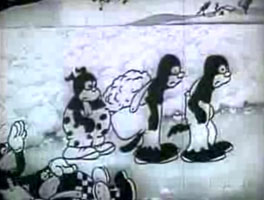 These latter two at first don't have the long ears so apparently were supposed to be blackfolk people instead of blackfolk animals, & yet they did have tails, & before the scene ends, they suddenly have the dog ears, as though someone happened by while the sheets were being illustrated & pointed out the lack. These latter two at first don't have the long ears so apparently were supposed to be blackfolk people instead of blackfolk animals, & yet they did have tails, & before the scene ends, they suddenly have the dog ears, as though someone happened by while the sheets were being illustrated & pointed out the lack.
One is getting the distinct imrpession the animators believed black folks unlike white folk just were animals & did have tails.
At long last we meet Uncle Tom, who is a fat old tom cat, yuk yuk. He's playing pennywhistle in front of his cabin. Tom puts one of his shoes on the end of the whitle to mute it.
In cartwheels happy Topysy, who is a chimpanzee-like toddler dressed up like a pickaninny. We get our first line of dialogue: "Hello Topsy. Where's Little Eva?"
Well, at least the white child is an ugly creature too. In fact she's a baby hippopotamus skipping aroud in a tutu. She joins Topsy & they tapdance together as Tom plays "Swanee River" on his pennywhistle.
In comes the evil dog villain Simon, with a bullwhip, threatening Tom with trumpet sounds coming out of his yammering face. He whips Tom off screen, Topsy follows, & fat Little Eva remains alone crying with her big hippo mouth wide open.
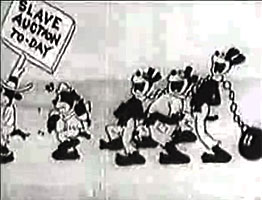 A dog carries a sign that says "Slave Auction To-Day." Behind him another dog in a small hat plays banjo. Behind him are three dogs chained together. They're the slaves to be sold, all singing happily. A dog carries a sign that says "Slave Auction To-Day." Behind him another dog in a small hat plays banjo. Behind him are three dogs chained together. They're the slaves to be sold, all singing happily.
On the auction block, a tired old Tom is tapdancing with a woeful look, while white-face dogs in hats stand around smoking cigars & wearing big hats deciding how much to bid. Old Tom puts on quite a show flexing his small muscles to get a tinkly jazz tune out of his skinny arms. Weirdly talented though he is, nobody bids.
Topsy goes on the auction block next, dancing on the individual boards as upon a xylophone. No one bids so she gives the plantation owners the raspberry. The audience chants "We want Liza! We want Liza!"
Simon twirls his mustache & decides to sell Lizah. She's washer her infant in a tub when she hears of it, & decides to flee from slavery, her infant in arms. What animator thought this was funny?
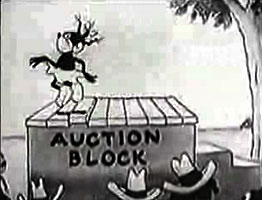 Simon brings out dozens of hounds to track her into the Great Southern Mountains, wherever those are, where Lizah leaping from ice chunk to ice chunk to cross a river, dog-dogs in swift pursuit behind. Iceflow gags predominate, inspired by a very popular D. W. Griffith film, Way Down East (1920). Simon brings out dozens of hounds to track her into the Great Southern Mountains, wherever those are, where Lizah leaping from ice chunk to ice chunk to cross a river, dog-dogs in swift pursuit behind. Iceflow gags predominate, inspired by a very popular D. W. Griffith film, Way Down East (1920).
Topsy runs off to find Uncle Tom, who is chained to a big iron ball. Dragging the ball, he rushes to save Liza befdore she goes over a falls. He gets out of his iron ball, & tosses it to Simon just as he goes over the falls in a little rowboat smashed up by the iron ball.
Topsy, Tom, & Liza sing "Way Down South in Dixie" with Mickey playing a guitar, & a crow-like rooster standnig at their side.
Despite the happy ending, & despite the slave owners being overt villains, there's not much in favor of this fabulously racist cartoon, except the racism itself, which is so much more over-the-top than usual. As such, it is probably less psychologically harmful than subtler racism or the hundreds of stereotypes encountered in other cartoons. This is so extreme it just makes the producers seem to be the morons.
 Down in Dixie (1932) is a partial remake of Dixie Days. And though it was a commonplace in early cartoons to recycle footage, this second version seems to have been produced specifically to do away with the slave block sequence, which somebody must've thought overstepped propriety even by their own racially insensitive measuring rod. Down in Dixie (1932) is a partial remake of Dixie Days. And though it was a commonplace in early cartoons to recycle footage, this second version seems to have been produced specifically to do away with the slave block sequence, which somebody must've thought overstepped propriety even by their own racially insensitive measuring rod.
The remake begins with the steamboat but without any of the scenes on the deck. It goes directly to Uncle Tom playing his pennywhistle for Topsy, Hippo Eva's arrival, her & Topsy's tapdance, & Simon skipping over to whip Tom.
It then completely skips the what was a length slave block sequence in Dixie Days, & goes to Liza's Laundry where she's washing her baby. She's warned she's going to be sold, so she flees from slavery.
In this version, the hounds chase Tom, Topsy, Liza & her baby over the ice flow. One of the gags from the first version, of a dog frozen in ice, has two completely different dogs in the same gag, with no perceivable reason for re-drawing rather than recycling the images
The scene of Simon blowing his hat like a horn was originally done next to the slave block, but redrawn without the slave block. Tom, Topsy, & Liza arrive at the North Pole, where polar bears & walruses live alongside Penguins. A text card appears that says, "And then night fell for six months!!!"
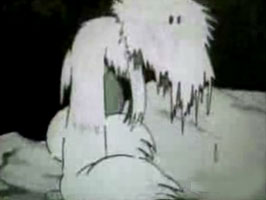 The escaped slaves attempt to go to sleep out in the open, presumedly until the sun comes up. They are evidently impervious to the cold, not even requiring blankets. Tom is awakened by a giant skull made of snow, then sees a really huge bigfoot creature. The escaped slaves attempt to go to sleep out in the open, presumedly until the sun comes up. They are evidently impervious to the cold, not even requiring blankets. Tom is awakened by a giant skull made of snow, then sees a really huge bigfoot creature.
Tom goes down on his knees to pray, & now we get the first strong actual words of the cartoon, Tom singing a jazzy hymn: "You make the river flow, the flowers grow/ You made the week & the strong/ But Lord, you made the night too long.
"You made the robin sing a song of spring/ And me you gave a lonely song/ Oh Lord, that's why the night's so long."
An instrumental to this well sung number follows, with animals & a strange loaping monster dancing. Two gloomy snowmen are forced to march by a third snowman with a rifle; there's apparently slavery even among snowmen.
Tom stumbles upon two skeletons asleep in the snow, one with a hot water bottle. He begins to sing: "I got a heart & I got a cabin/ The door is open wide/ What good's a heart, & what good's a cabin/ If nobody lives inside!"
He flees from the skeletons back to Liza, Topsy, & the baby, & they all reprise the final line, "But Lord you made the night too long!"
The paddle steamboat arrives & Simon's on board to reclaim his slaves. But a walrus threatens him & the family escapes from the Polar ice cap, singing, "We're going back to Dixie, hooray, hooray, hooray!" One can only hope manumition occurs before they get there.
copyright © by Paghat the Ratgirl
|
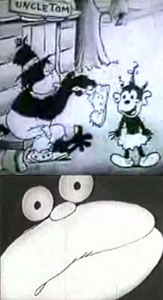

 These latter two at first don't have the long ears so apparently were supposed to be blackfolk people instead of blackfolk animals, & yet they did have tails, & before the scene ends, they suddenly have the dog ears, as though someone happened by while the sheets were being illustrated & pointed out the lack.
These latter two at first don't have the long ears so apparently were supposed to be blackfolk people instead of blackfolk animals, & yet they did have tails, & before the scene ends, they suddenly have the dog ears, as though someone happened by while the sheets were being illustrated & pointed out the lack. A dog carries a sign that says "Slave Auction To-Day." Behind him another dog in a small hat plays banjo. Behind him are three dogs chained together. They're the slaves to be sold, all singing happily.
A dog carries a sign that says "Slave Auction To-Day." Behind him another dog in a small hat plays banjo. Behind him are three dogs chained together. They're the slaves to be sold, all singing happily. Simon brings out dozens of hounds to track her into the Great Southern Mountains, wherever those are, where Lizah leaping from ice chunk to ice chunk to cross a river, dog-dogs in swift pursuit behind. Iceflow gags predominate, inspired by a very popular D. W. Griffith film, Way Down East (1920).
Simon brings out dozens of hounds to track her into the Great Southern Mountains, wherever those are, where Lizah leaping from ice chunk to ice chunk to cross a river, dog-dogs in swift pursuit behind. Iceflow gags predominate, inspired by a very popular D. W. Griffith film, Way Down East (1920).
 The escaped slaves attempt to go to sleep out in the open, presumedly until the sun comes up. They are evidently impervious to the cold, not even requiring blankets. Tom is awakened by a giant skull made of snow, then sees a really huge bigfoot creature.
The escaped slaves attempt to go to sleep out in the open, presumedly until the sun comes up. They are evidently impervious to the cold, not even requiring blankets. Tom is awakened by a giant skull made of snow, then sees a really huge bigfoot creature.